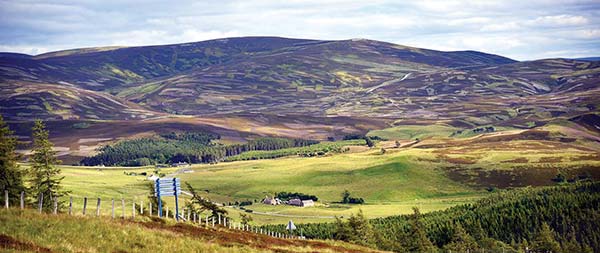
Pitlochry • Sights West of the Cairngorms • Loch Tay • Speyside Whisky Trail • Balmoral Castle & the Royal Deeside • Dunnottar Castle
Balmoral Castle and Royal Deeside
Between Edinburgh and Inverness, the eastern expanse of Scotland bulges out into the North Sea. The main geological landmark is Cairngorms National Park, with gently rugged Highland scenery and great hiking terrain. If your time is limited, Scotland is more satisfying elsewhere. But this region is easily accessible—you’ll likely pass through at some point—and has a lot to offer, especially for those with special interests.
This chapter is organized geographically: sights west and east of the Cairngorms. Those in a hurry should focus on the west, where the A-9 highway links up some fun choices. Pitlochry has a green-hills-and-sandstone charm, a warm welcome, and a pair of great distilleries linked by a nice hike, making it the region’s best overnight stop. Nearby you’ll find a fascinating trip back to prehistory (at the Scottish Crannog Centre on Loch Tay), a fun sheepdog show, and an open-air folk museum.
East of the Cairngorms, the attractions require more of a detour (most convenient for those connecting Inverness and St. Andrews), but an even better look at rural Scotland. Whisky connoisseurs flock to Speyside, royalists visit Balmoral Castle and the nearby home-base village of Ballater, and ruined-castle fans head to Dunnottar.
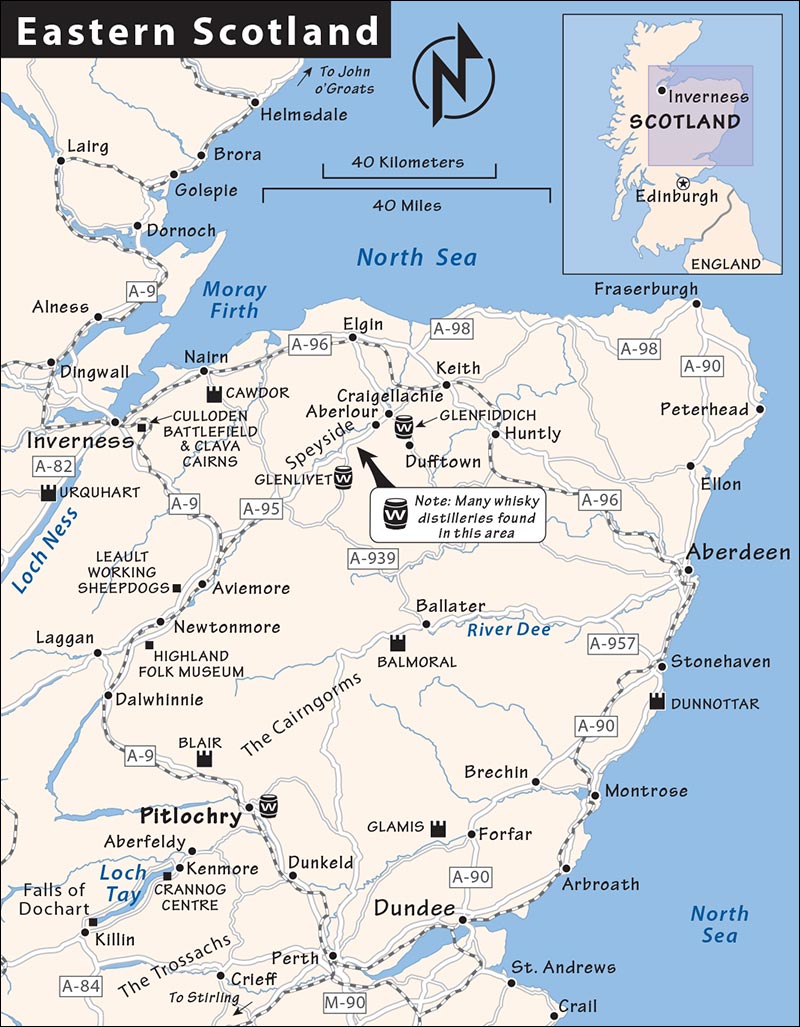
The A-9 highway, connecting Inverness, Stirling, and Edinburgh, may be Scotland’s most touristy road. Heading south on the A-9, soon after leaving Inverness, the highway begins to skirt around the curved west edge of Cairngorms National Park, which it follows almost all the way to Pitlochry. These bald, heather-covered hills are what many people picture when they imagine Highland scenery. The best look at the Cairngorms is on the east side of the park, around the village of Ballater and Balmoral Castle (see here); the A-939, connecting the valley of the River Spey to Ballater, is particularly dramatic. But you’ll get a decent glimpse of scenery along the A-9.
As you follow the A-9, it seems every exit is stacked with brown “tourist attraction” signs. For the most part, the options along here are more convenient than good; they tend to pale in comparison to alternatives elsewhere in the country. But if your trip to Scotland isn’t taking you beyond this Highland corridor, some of these may be worth a stop. Pitlochry, described next, is the top town (particularly for those seeking a handy overnight); after that, I’ve listed more options in the order you’ll reach them traveling from Inverness to Edinburgh.
This likable tourist town, famous for its whisky and its hillwalking (both beloved by Scots), makes an enjoyable overnight stop. Just outside the craggy Highlands, Pitlochry is set amid pastoral rolling hills that offer plenty of forest hikes. It seems that tourism is the town’s only industry—with perhaps Scotland’s highest concentration of woolens shops and outdoor outfitters. (The name “Pitlochry” comes from the old Pictish word for “tourist trap.”) But Pitlochry also has the feel of a real community. People here are friendly and bursting with town pride: They love to chat about everything from the high-quality local theater to the salmon ladder at the hydroelectric dam. It’s also a restful place, where—after the last tour bus pulls out—you can feel your pulse slow as you listen to gurgling streams.
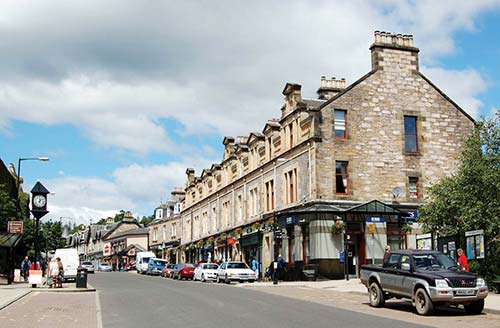
Plucky little Pitlochry (pop. 2,500) lines up along its tidy, tourist-minded main street, Atholl Road, which runs parallel to the River Tummel. The train station is on Station Road, off the main street. Its two distilleries are a walk—or short drive—out of town (see my self-guided whisky walk). Navigate by following the black directional signs to Pitlochry’s handful of sights.
The helpful TI, at one end of town, has free Wi-Fi and sells maps for local hill walks and scenic drives. Their good £1 Pitlochry Path Network brochure is handy (Mon-Sat 9:30-17:30, Sun 10:00-16:00, longer hours in summer, shorter hours and closed Sun Nov-March; 22 Atholl Road, tel. 01796/472-215).
Special Events: In summer, a pipe band marches through town every Monday evening. In May and June, the salmon ladder at the dam comes to life (described later, under “Sights in Pitlochry”). Pitlochry’s Highland Games are in early September (www.pitlochryhighlandgames.co.uk). And in October, the Enchanted Forest light-and-water show set to music illuminates Faskally Wood, just outside of town (www.enchantedforest.org.uk).
Bike Rental: Escape Route Bikes, located across the street and a block from the TI (away from town), rents a variety of bikes (£16/5 hours, £24/24 hours, includes helmet and lock if you ask, Mon-Sat 9:00-17:30, Sun 10:00-17:00, 3 Atholl Road, tel. 01796/473-859, www.escape-route.co.uk).
Parking: Drivers who aren’t spending the night can park in the large pay-and-display lot next to the TI, in the center of town.
Pitlochry’s two distilleries can be linked by a relaxing two-hour hike (described later, under “Whisky Walk.”) For background on types of whiskies, how whisky is made, and tasting it like a pro, see here.
This cute distillery (pronounced ED-rah-dower)—the smallest historic distillery in Scotland (est. 1825)—takes pride in making its whisky with a minimum of machinery, and maintains a proud emphasis on tradition. Small white-and-red buildings are nestled in a delightfully green Scottish hillside. (“Edradour”—also the name of the stream that gurgles through the complex—means “land between two rivers.”) With its idyllic setting and gregarious spirit, it’s one of the most enjoyable distillery tours in Scotland. Unlike the bigger distilleries, they allow you to take photos of the equipment. If you like the whisky, buy some here and support the Pitlochry economy—this is one of the few independently owned distilleries left in Scotland.

Cost and Hours: £7.50 for a one-hour tour, departs 3/hour, April-Oct Mon-Sat 10:00-17:00, closed Sun and off-season, last tour departs one hour before closing, tel. 01796/472-095, www.edradour.com.
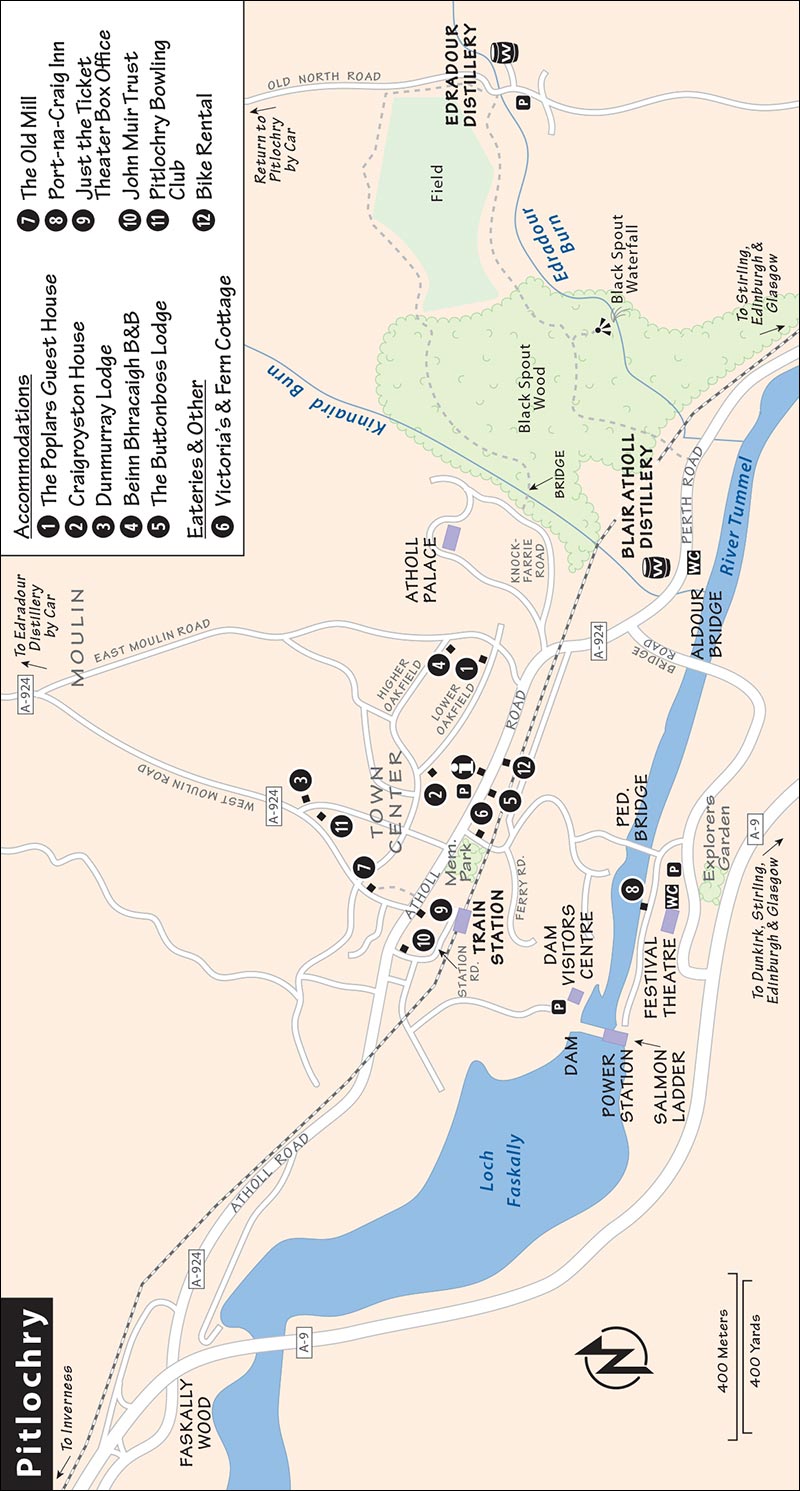
Getting There: Most come to the distillery by car (follow signs from the main road, 2.5 miles into the countryside), but you can also get there on a peaceful hiking trail that you’ll have all to yourself (follow my “Pitlochry Whisky Walk,” next page).
Visiting the Distillery: You’ll watch a 10-minute orientation film, then enjoy a sit-down education while tasting two different drams. Then the guided tour proceeds through the facility: from the malt barn (where the barley is germinated and dried) to the still (where giant copper stills turn distiller’s beer into whisky) to the warehouse (where 6,000 casks age in the darkness). Take a deep whiff of the rich aroma—you’re smelling the so-called “angels’ share,” the tiny percentage of each cask that’s lost to evaporation.
This big, ivy-covered facility is conveniently located (about a half-mile from the town center) and more corporate-feeling, offering hour-long tours with a wee taste at the end. I’d tour this only if you’re a whisky completist, or if you lack the wheels or hiking stamina to reach Edradour.
Cost and Hours: £7.50, Easter-Oct tours depart 2/hour daily 10:00-17:00, July-Aug until 17:30, last tour departs one hour before closing; shorter hours, fewer tours, and closed Sat-Sun off-season; tel. 01796/482-003, www.discovering-distilleries.com/blairathol.
A fun way to visit the distilleries is to hill walk from downtown Pitlochry. The entire loop trip takes 2-3 hours, depending on how long you linger in the distilleries (at least an hour of walking each way). You’ll see lush fern forests and a pretty decent waterfall. The walk is largely uphill on the way to the Edradour Distillery; wear good shoes, bring a rain jacket just in case, and be happy that you’ll stroll easily downhill after you’ve had your whisky samples.
At the TI, pick up the Pitlochry Path Network brochure and follow along with its map. You’ll be taking the Edradour Walk (marked on directional signs with yellow hiker icons; on the map it’s a series of yellow dots). Leave the TI and head left along the busy A-924. The walk can be done in either direction, but I’ll describe it counterclockwise.
Within 10 minutes, you’ll walk under the railroad tracks and then come to Bell’s Blair Athol Distillery on your left. If you’re a whisky buff, stop in here. Otherwise, hold out for the much more atmospheric Edradour. You’ll pass a few B&Bs and suburban homes, then a sign marked Black Spout on a lamppost. Just after this, you’ll cross a bridge, then take the next left, walking under another stone rail overpass and away from the road. Following this path, you’ll come to a clearing, and as the road gets steeper, you’ll see signs directing you 50 yards off the main path to see the “Black Spout”—a wonderful waterfall well worth the few extra steps on your right.
At the top of the hill, you’ll arrive in another clearing, where a narrow path hugs a huge field on your left. Low rolling hills surround you in all directions. It seems like there’s not another person around for miles, with just the thistles to keep you company. From here it’s an easy 20 minutes to the Edradour Distillery.
Leaving the distillery, to complete the loop, head right, following the paved road (Old North Road). In about 50 yards, a sign points left into the field. Take the small footpath that runs along the left side of the road. (If you see the driveway with stone lions on both sides, you’ve gone a few steps too far.) You’ll walk parallel to the route you took getting to the distillery, hugging the far side of the same huge field. The trail then swoops back downhill through the forest, until you cross the footbridge and make a left. You’ll soon reach Knockfarrie Road—take this downhill; you’ll pass a B&B and hear traffic noises as you emerge from the forest. The trail leads back to the highway, with the TI a few blocks ahead on the right.
Pitlochry’s main street is a pleasant place to wander and window-shop. As you stroll, consider this: The town exists thanks to the arrival of the train, which conveniently brought Romantic Age tourists from the big cities in the south to this lovely bit of Scotland. Queen Victoria herself visited three times in the 1860s, putting Pitlochry on the tourist map. The postcard-perfect Victorian sandstone architecture on the main street makes it clear that this was a delightful escape for city folks back in the 19th century.
Here are some things to look for, listed in order of how you’ll reach them from the TI. The memorial park with the Celtic cross honors men from the local parish whose lives were lost fighting in World War I—a reminder of Scotland’s disproportionate sacrifices in that conflict. Throughout Scotland, even many tiny villages have similar monuments.
Ferry Road, next to the park, branches off under the rail bridge and leads to a footbridge that takes you to the other side of the river—home to Pitlochry’s spunky Festival Theatre, as well as a power station with a salmon ladder (a fun excuse for a lazy walk—described later).
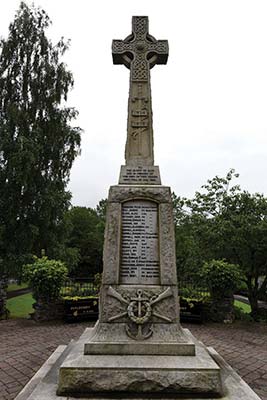
Peek inside The Hardware Centre. In small towns like Pitlochry—without a Wal-Mart (I mean, Tesco)—shops like this serve as catch-all general stores for the community. In addition to hardware, it carries a full range of kitchenware.
The Love Your Sweets shop, with a purple awning, stocks a staggering variety of uniquely Scottish candies in bulk. Step in to buy a mixed bag of some unusual flavors of hard candies, such as clove, rhubarb, or Irn-Bru. At the next little park on the right, a surging stream angles away from the main road and to the recommended Old Mill restaurant.
On the corner with Station Road is the headquarters of the John Muir Trust. John Muir (1838-1914) was born in Scotland, moved to the US when he was 10, and later helped establish the world’s first national park system in the US. Inside is a free tiny exhibit called Wild Land, with a feel-good nature video and a small art gallery. They also sell books, maps, and other conservation-themed souvenirs (Mon-Sat 10:00-17:00, Sun 11:00-16:00, shorter hours and closed Tue off-season, tel. 01796/470-080, www.jmt.org).
The Pitlochry Bowling Club lets outsiders rent shoes and balls and try their hand at the game (£3, generally Mon-Fri 10:00-12:00 & 14:00-16:00, 24 West Moulin Road, tel. 01796/473-459).
These sights lie along the largely undeveloped riverbank opposite Pitlochry’s town center. While neither are knockouts, they’re a fine excuse for a pretty stroll or drive. Walkers can reach this area easily in about 15 minutes: Head down Ferry Road (near the memorial park), cross the footbridge, and turn right.
Pitlochry’s dam on the River Tummel provides a nice place to go for a stroll, and comes with a salmon ladder—a series of chambers that allow salmon to “step” their way upstream next to the dam (salmon generally run May-June).
The well-designed and family-friendly Visitors Centre celebrates hydroelectric power in the Highlands. Its fine nine-minute video, “Power from the Glens,” explains the epic vision of generating clean power from—and for—the Highlands. You can also walk all the way across the top of the dam, pausing to read informational plaques and to peer through windows into the hydroelectric plant (free, daily 9:30-17:30). Their cafeteria is delightful with a nice river view.
This theater company rotates its productions, putting on a different play every few nights. Most are classics, with a few musicals and new shows mixed in (£15-35; plays generally run May-Oct Mon-Sat). The theater hosts concerts on Sunday evenings—usually tribute acts—and a variety of other performances in winter (purchase tickets online or by phone; in person at Just the Ticket—Mon-Sat 9:00-17:00, closed Sun, 89 Atholl Road; or at the theater—same price, box office open daily 10:00-20:00, tel. 01796/484-626, www.pitlochryfestivaltheatre.com).
Nearby: Just above the theater’s parking lot, the six-acre Explorers Garden features plants and wildflowers from around the world (£4, daily 10:00-17:00, closed Nov-March, last entry 45 minutes before closing, tel. 01796/484-626, www.explorersgarden.com).
All of these have free parking.
$$ The Poplars Guest House, perched regally on a meticulously landscaped hill high above the main road, has been stylishly renovated by Jason and Nathalie. The huge home has a spacious lounge with views, and six rooms that combine modern comforts with a respect for tradition. Start the day off right with their whisky porridge (family room, closed in winter, at the end of Lower Oakfield at #27, tel. 01796/472-129, www.poplars-pitlochry.com, info@poplars-pitlochry.com).
$$ Craigroyston House, my sentimental favorite in Pitlochry, is a quaint, large Victorian country house with eight large and luxe bedrooms. Their terraced yard is a great place to sip some wine or play croquet. Vaughan and Susan, originally from Orkney, are welcoming and generous (family rooms, right above the TI parking lot at 2 Lower Oakfield, tel. 01796/472-053, www.craigroyston.co.uk, reservations@craigroyston.co.uk). Drivers can reach it on Lower Oakfield Road; walkers can walk up from the huge parking lot next to the TI on Atholl Road (find the small gate at the back of the lot).
$$ Dunmurray Lodge is a calming place to call home, with four springtime-colored rooms, and friendly hosts (family room, no kids under 5; breakfast includes gluten-free, vegetarian, and other options; 5-minute walk from town at 72 Bonnethill Road, mobile 0778-346-2625, www.dunmurray.co.uk, lorraine@dunmurray.co.uk, Lorraine and Mike).
$$ Beinn Bhracaigh (pronounced “benny vrackie,” meaning “speckled mountain”) is a guesthouse with a hotel feel. The 13 rooms are modern and tasteful, and they have a sitting room where you can serve yourself at the well-stocked honesty bar. Of my listings, it sits the highest above the main road—still within a (longish, steep) walk, but easier by car. The location comes with fine views across the town center and river to the hills beyond (minimum two-night stay in peak season and on weekends, no kids under 8, no elevator, 14 Higher Oakfield, tel. 01796/470-355, www.beinnbhracaigh.com, info@beinnbhracaigh.com, James and Kirsty).
$ The Buttonboss Lodge has a less idyllic setting, right along the busy main road across from the TI (expect some traffic noise). But it’s affordable and convenient for train travelers. The eight rooms, managed by Cristian, are straightforward and a bit old-fashioned (25 Atholl Road, tel. 01796/472-065, mobile 0790-247-2065, www.buttonbosslodge.co.uk, info@buttonbosslodge.co.uk).
(See “Pitlochry” map, here.)
Plenty of options line the main drag, including several bakeries selling picnic supplies.
$$ Victoria’s restaurant and coffee shop, a local favorite, feels like a down-home diner, serving up an eclectic menu of comfort food (daily 10:00-21:00, patio seating, free Wi-Fi, at corner of memorial park, 45 Atholl Road, tel. 01796/472-670).
$$$ The Old Mill, tucked a block behind the main drag in an actual old mill, has good Scottish food, plus some pastas and salads. Sit in their popular, high-energy pub, calmer restaurant in back, or at picnic tables outside (food served daily 12:00-21:00, tel. 01796/474-020).
$$$ Fern Cottage, just behind Victoria’s, has a darker, candlelit, dressier ambience and a Mediterranean spin on their menu (daily 12:00-15:00 & 17:00-20:30, Ferry Road, tel. 01796/473-840).
$$$ Port-na-Craig Inn, on the river just downhill from the theater, is a fancier option catering to theatergoers. For a calmer experience, go at 20:00, after the show has started (lunch specials, daily 11:00-21:00, tel. 01796/472-777).
The train station is open Monday to Saturday 8:00-18:30 and Sunday 10:30-18:00.
From Pitlochry by Train to: Inverness (almost hourly, 2 hours), Stirling (5/day direct, 1 hour, more with transfer in Perth), Edinburgh (8/day direct, 2 hours), Glasgow (9/day, 2 hours, some transfer in Perth). Train info: Tel. 0845-748-4950, www.nationalrail.co.uk.
By Bus to: Glasgow (1/day direct on National Express #588; 5/day on Citylink to Perth, then change to Megabus to Glasgow, 2.5 hours—train is faster), Edinburgh (3/day on Citylink #M90, 2.5 hours).
Each afternoon, Neil Ross presents a 45-minute demonstration of his well-trained sheepdogs. The experience is vividly real and fascinating. You’ll hunker down in a natural little amphitheater in the turf while Neil describes his work. He’ll demonstrate why shepherds have used a crook for thousands of years, and explain why farmers get frustrated when “fancy people with numbers after their names” try to tell them how to manage their land. Then the dogs get to work: With shouts and whistles, each dog follows individual commands, demonstrating an impressive mastery over the sheep. (Watching in awe, you can’t help but think: Sheepdogs are smart...and sheep are idiots.) After the presentation, you’ll meet (and pet) the border collie stars of the show, and may have the chance to feed some lambs or to try your hand at shearing sheep. If they happen to have a litter of border collie puppies, even those who dislike dogs may find it hard to resist smuggling one home.

Cost and Hours: £5, demonstration only once per day, May-Oct Sun-Fri at 16:00, closed to the public at other times, no demonstrations Sat or Nov-April, tel. 01540/651-402, www.leaultworkingsheepdogs.co.uk.
Getting There: The entrance to the farm is a gravel road that literally runs across the A-9. But since the little road sneaks up on you, it’s safer to exit for Kincraig, then follow the brown signs around to a driveway that takes you (carefully) back across the A-9 and up to the farm.
Scotland doesn’t have a top-notch open-air folk museum—but this is close enough. Just off the highway on the outskirts of Newtonmore, the museum features re-creations of traditional buildings from the surrounding area from the 1700s through the 1930s. The buildings are a bit spread out, and it’s quiet outside of frequent “activity days” (check the schedule online).
Cost and Hours: Free but donations welcome, daily April-Aug 10:30-17:30, Sept-Oct 11:00-16:30, closed Nov-March, helpful £5 guidebook, tel. 01540/673-551, www.highlifehighland.co.uk.
Getting There: Exit the A-9 in Newtonmore, then follow brown signs for about five minutes through the village to the museum (free parking).
Visiting the Museum: The highlight of the museum is a circa-1700, thatched-roof Highland township called Baile Gean, a gathering of four primitive stone homes and three barns, each furnished as it would have been in the Jacobite era (it’s a 15-minute walk from the entry—go to the right through a pine forest and up a small hill). Although built for the museum, the township was closely based on an actual settlement a few miles away that was populated until the 1830s. Costumed docents can explain traditional Highland lifestyles, and you’ll likely see—and smell—a peat fire filling one of the homes with its rich smoke. (Because peat doesn’t spit or spark, it was much safer to burn than wood—which was too valuable to feed fires anyway, as most tools were made of wood.) This area provided an ideal backdrop for some of the rural-life scenes in the TV production of Outlander (see sidebar on here).
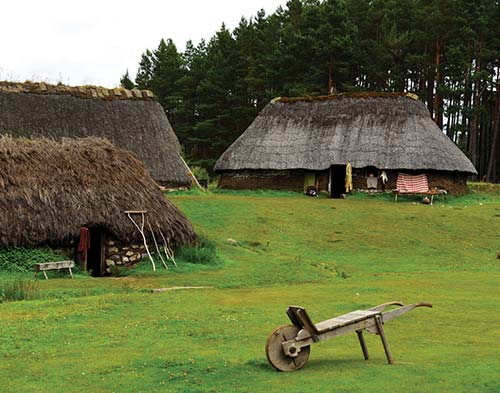
With more time, visit the other structures in the rest of the open-air museum, such as the tweed shop; the schoolhouse, where you’ll learn about early-20th-century classrooms; or the Lochanhully House (look for the house with red eaves, past the playground), which depicts a 1950s Scottish home. At the far end of the complex you may see some hairy “coos.”
If you like Scottish history, heritage, and antlers, you’ll like Blair Castle. It’s a convenient stop for those zipping past on the A-9. In Gaelic, a “blàr” or “blair” is a flat bit of land surrounded by hills. And sure enough, this stately, white palace rises up from a broad clearing. A stout fortress during the Jacobite wars, it was later renovated and expanded as a mansion in the Scottish Baronial style.

The former residence of the Dukes of Atholl (a.k.a. Clan Murray) is now owned and run as a business by a trust. It’s filled with paintings, historic artifacts, Clan Murray mementoes, and grand, creaky staircases. Following the self-guided, one-way route, you’ll enjoy a fine look at 19th-century aristocratic life. The WWI room recalls how the house was used as a hospital during that conflict. A highlight is the wood-paneled ballroom at the end, draped in tartan and bristling with antlers.
If time allows, explore the grounds—especially the walled Hercules Garden, where rugged plantings surround a lily-padded pond, overlooked by a statue of Hercules (accessed via the trail near the parking lot).
Cost and Hours: £11, April-Oct daily 9:30-17:30, closed Nov-March, last entry one hour before closing, tel. 01796/481-207, www.blair-castle.co.uk.
Getting There: From the town of Blair Atholl (just off of the A-9), drive down the long, tree-lined driveway to the free parking lot. From Pitlochry, you can take the more scenic B-8019/B-8079 instead of the A-9. Bus #87 runs from Pitlochry (5/day in summer, fewer off-season, 15 minutes, www.elizabethyulecoaches.co.uk).
Nearby: The Atholl Country Life Museum is a humble, volunteer-run museum literally across the street from Blair Castle. A local teacher created these exhibits, filling an old school to show the other side of the social and economic coin. Chatting with the volunteers makes a visit extra fun (£4, generally daily 13:30-17:00, July-Aug from 10:00, tel. 01796/481-232, www.athollcountrylifemuseum.org.uk).
This charming wee town, just off the A-9, is worth a stretch-your-legs break. While the town center is pleasant—with flower boxes and cleverly named shops—its claim to fame is its partially ruined cathedral, which sits on the banks of the River Tay.
Pay-and-display parking is at both ends of town (the north end has a WC). The TI and cathedral are just down High Street from the main drag, Atholl Street.
The Cathedral of St. Columba was actually Scotland’s leading church for a brief time in the ninth century, when that important saint’s relics were being stored here during Viking raids. Later it blossomed into a large cathedral complex in a secluded, riverside setting. But it was devastated by the one-two punch of Reformation iconoclasts (who tore down most of the building) and Jacobites (who fought the Battle of Dunkeld near here). Duck inside to see the stony interior and its one-room museum (pick up the free info sheet or consider borrowing the good audioguide for a £1 donation). Outside, as you circle the entire complex, you’ll discover that the current church is merely the choir of the original structure—a huge, ruined nave (currently undergoing restoration) stretches behind it.
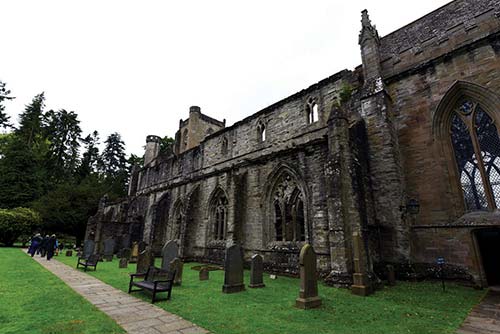
The $ Scottish Deli is nice for a drop in, with soups, sandwiches, and salads (a few tables inside, corner of High Street and Atholl Street, tel. 01350/728-028).
A 30-minute drive west of the A-9, Loch Tay is worth visiting mostly for its excellent Scottish Crannog Centre—the best place in Scotland to learn about early Iron-Age life. You can also drive along Loch Tay (and past the thundering Falls of Dochart) to connect Pitlochry and the A-9 corridor with the Trossachs and Loch Lomond.
Across Scotland, archaeologists know that little round islands on the lochs are evidence of crannogs—circular houses on stilts, dating to 500 years before Christ. Iron-Age Scots built on the water because in an age before roads, people traveled by boat, and because waterways were easily defended against rampaging animals (or people). Scientists have found evidence of 18 such crannogs on Loch Tay alone. One has been rebuilt, using mostly traditional methods, and now welcomes visitors. Guided by a passionate and well-versed expert, you’ll spend about an hour visiting the crannog and learning about how its residents lived.
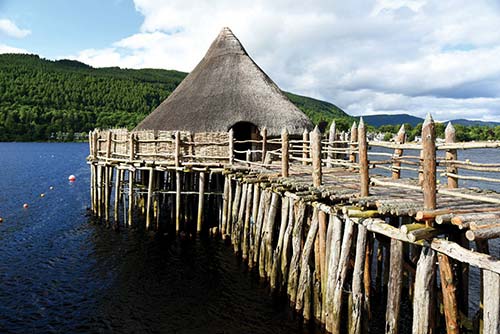
Cost and Hours: £10, family tickets available, daily 10:00-17:30, closed Nov-March, well-marked just outside Kenmore on the south bank of Loch Tay, tel. 01887/830-583, www.crannog.co.uk.
Visiting the Museum: The highlight is the two-part tour, led by guides dressed in prehistoric garb. Join whichever group is going next.
One part of the tour takes you out across the rustic wooden bridge to the crannog itself, where you’ll huddle under the thatched roof and learn about Iron Age architecture. Your guide explains how families of up to 20 people lived in just one crannog—along with their livestock—and paints a vivid picture of what life was like in those rugged times.

In the other part of the tour, guides demonstrate Iron Age “technology”—turning a lathe, grinding flour, spinning yarn, and even starting a fire using nothing but wood and string. You’ll then have a hands-on opportunity to try the tools yourself—and realize how easy the guides made it look.
A modest exhibit just off the gift shop explains the history of crannogs, excavation efforts, and the building of this new one.
Located where Loch Tay empties into the River Tay, Kenmore is a sleepy, one-street, black-and-white village with a big hotel, a church, and a post office/general store. There’s not much to do here, other than visit the nearby Scottish Crannog Centre, enjoy the Loch Tay scenery, and consider hiking through the woods to the Taymouth Castle (currently being renovated). With its classic old hotel, Kenmore can be a handy home base for this area.
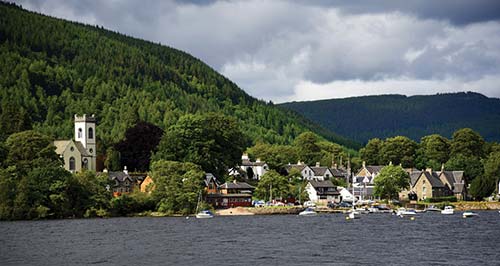
Sleeping and Eating in Kenmore: $$ Kenmore Hotel, dominating the village center, feels like a classic Scottish country hotel—it claims to be the oldest inn in Scotland (dating from 1572). The 39 rooms are old-fashioned but cozy, and welcoming lounges, terraces, and other public spaces sprawl through the building. Look for the Robert Burns poem above the fireplace in one of the bars (elevator, The Square, Kenmore, tel. 01887/830-205, www.kenmorehotel.com, reception@kenmorehotel.com). The $$$ pub, dining room, and various outdoor dining areas all share the same menu.
At the far end of Loch Tay from Kenmore, in the village of Killin, the road passes on a stone bridge over a churning waterfall where the peat-brown waters of the River Dochart tumble dramatically into the loch. The romantic bridge is busy with passing motorists enjoying a photo op; eateries and gift shops surround the scene. You can clamber down onto the flat stones for a closer look. From the bridge, notice the stone archway marking the burial ground of the Clan Macnab.

While the A-9 corridor to the west is studded with touristy amusements, the area east of the Cairngorms (while hardly undiscovered) feels more rugged and lets you dig deeper into the countryside. In this area, I’ve focused on two river valleys with very different claims to fame: Speyside, curling along the top of the Cairngorms, is famous for its many distilleries; Royal Deeside, cutting through the middle of the Cairngorms, is the home of the Queen’s country retreat at Balmoral and the neighboring village of Ballater. Overnighting in Ballater is an ideal way to linger in this region and sleep immersed in Cairngorms splendor.
Of the hundred or so distilleries in Scotland, half lie near the valley of the River Spey—a small area called Speyside. The ample waters of the river, along with generous peat deposits, have attracted distillers here for centuries. While I prefer some of the smaller, more intimate distillery tours elsewhere (including Oban Distillery in Oban, Talisker on the Isle of Skye, and Edradour near Pitlochry), Speyside is convenient to Inverness and practically a pilgrimage for aficionados. The distilleries here feel bigger and more corporate, but they also include some famous names (including the world’s two best-selling brands of single malts, Glenfiddich and Glenlivet). And for whisky lovers, it’s simply enjoyable to spend time in a region steeped in such reverence for your favorite drink.
A quick car tour of Speyside takes about a half-day, and is a scenic way to connect Inverness to Royal Deeside (it also works as a side-trip from Inverness). Whisky aficionados will have their own list of distilleries they want to hit. But, for the typical traveler, here is an easy plan for the day:
Enjoy the scenic drive to Aberlour, tour the Speyside Cooperage, tour the Glenfiddich distillery, and finally have a short stop in Dufftown. These four stops are within about five miles of each other.
If driving south from Inverness, you could easily do these stops and then drive down to Balmoral Castle to tour it and sleep nearby in Ballater.
The A-95, which parallels the River Spey, is the region’s artery (to reach it, take the A-9 south from Inverness and turn off toward Grantown-on-Spey). Brown Malt Whisky Trail signs help connect the dots. While several distilleries lie along the main road, even more are a short side-trip away. Three humdrum villages form the nucleus of Speyside: Aberlour (the biggest), Craigellachie (a wide spot in the road), and Dufftown (with a clock tower and a good dose of stony charm).
Because public transit connections aren’t ideal, Speyside works best for drivers—though if you’re determined, you could take the train from Inverness to Elgin and catch the “whisky bus” from there (Stagecoach bus #38, stops in Craigellachie and Aberlour on the way to Dufftown, about hourly, none Sun).
A word of caution: In Scotland, DUI standards are very low (0.05 percent) and strictly enforced. Go easy on the tastings, or bring a designated driver. Distilleries are often happy to give drivers their dram “to go” so they can enjoy it safely later.
I’ve listed these roughly west to east, as you’ll reach them approaching Speyside on the A-95. For a good primer on whisky and whisky tastings, see here.
Officially named “Charlestown of Aberlour” for its founder, this attractive sandstone town lines up along the A-95. It’s famous both for its namesake whisky distillery (www.aberlour.com) and as the home of Walkers Shortbread, which you’ll see sold in red-tartan boxes all over Scotland (you can get some at the factory store in town, but no tours). $$ The Mash Tun, just off the main road (next to a welcoming little visitors center), is an atmospheric whisky bar that serves lunch and rents rooms upstairs (tel. 01340/881-771, www.mashtun-aberlour.com).
The blink-and-you’ll-miss-it village of Craigellachie (craig-ELL-a-kee) is home to the landmark $$ Craigellachie Hotel. This classic, grand old hotel, a handy home base for whisky pilgrims, is famous for its whisky bar—stocking more than 800 bottles (opens daily at 17:00, the receptionist may let you in for a peek at other times, 26 rooms, tel. 01340/881-204 www.craigellachiehotel.co.uk). Just past the hotel on the A-941, keep an eye out on the left for the picturesque Craigellachie Bridge, built by the great Scottish industrial architect Thomas Telford.
Note that the A-95 takes a sharp turn to the right in Craigellachie (just before the hotel), leading to the cooperage described next, and beyond that, to the Glenfiddich Distillery and Duffton; the main road (past the hotel and the bridge) becomes A-941.
Perhaps the single biggest factor in defining whisky’s unique flavor is the barrel it’s aged in. At this busy workshop on the outskirts of Craigellachie, you can watch master coopers build or refurbish casks for distilleries throughout Scotland. The 14 coopers who work here—and who must first complete a four-year apprenticeship to get the gig—are some of the last of a dying breed; while just about everything used to be transported in barrels, today it’s only booze. First you’ll view an engaging, almost tear-jerking 15-minute film, then you’ll follow your guide up to an observation deck peering down over the factory floor. Oak timber is shaped into staves, which are gathered into metal hoops, then steamed to make them more pliable. Finally the inside is charred with a gas flame, creating a carbonized coating that helps give whisky its golden hue and flavor. Because the vast majority of casks used in Scotland are hand-me-downs from the US (where bourbon laws only allow one use per barrel), you’re more likely to see reassembly of old casks (with new ends) rather than from-scratch creation of new ones. But the process is equally fascinating. Apart from observing the barrel-making, it’s also interesting to see the intensity of the workers—who are paid by the piece.
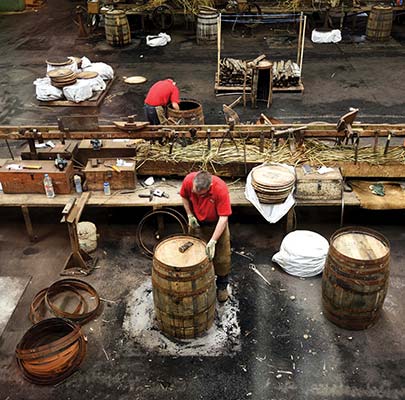
Cost and Hours: £3.50, tours depart every 30 minutes, Mon-Fri 9:00-15:30, closed Sat-Sun, Dufftown Road, Craigellachie, tel. 01340/871-108, www.speysidecooperage.co.uk.
As you enter Dufftown, keep an eye out on the left for the home of Scotland’s top-selling single malt whisky. This sprawling but charming factory—with a name that means “Valley of the Deer” (hence the logo)—offers excellent tours and tastings. After a 15-minute promotional video, your kilted guide will walk you through the impressive plant, which includes a busy bottling hall. Your tour finishes with an extensive tasting session.
Cost and Hours: Basic £10 “Explorers” visit includes 1.5-hour tour and 4 tastings (departs every 30 minutes), more expensive options available, daily 9:30-16:00 (last tour), tel. 01340/822-373, www.glenfiddich.com.
Glenfiddich or Glenlivet? The two big distilleries of Speyside each offer £10 tours and tastings. Both tours are excellent, and they handle their crowds very well. I prefer Glenfiddich as it feels more historic and less corporate, and it’s closer to other sights.
This charming, sleepy town has a characteristic crossroads street plan radiating from its clock-tower-topped main square. A few steps up Conval Street from the tower, the humble, one-room Whisky Museum doubles as the TI. You’ll see a small selection of historical displays and tools from the whisky trade. Most importantly, you’ll have a chance to chat with the fun retirees who run the place (free, daily 10:00-16:00 in summer, tel. 01340/821-591). The Whisky Shop, directly behind the tower, is a serious place selling 650 different types of whisky (daily 10:00-18:00, closed Sun in winter, 1 Fife Street, tel. 01340/821-097, www.whiskyshopdufftown.com).
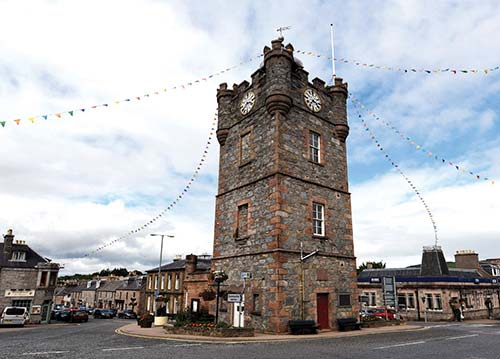
Sitting five miles south of the A-95 (turn off at Bridge of Avon), this is one of the area’s most famous and popular distilleries to tour. Their 75-minute tour spares you the gauzy video intro that comes with most tours and takes you right through the sprawling production facility—perched on a ridge overlooking Cairngorms National Park. The tour finishes with three tastings. If you’re not taking the tour, you’re welcome to enjoy their history exhibit room. Note: This is just a short detour for those connecting Speyside to Ballater on the scenic route through the mountains (B-9008/A-939).
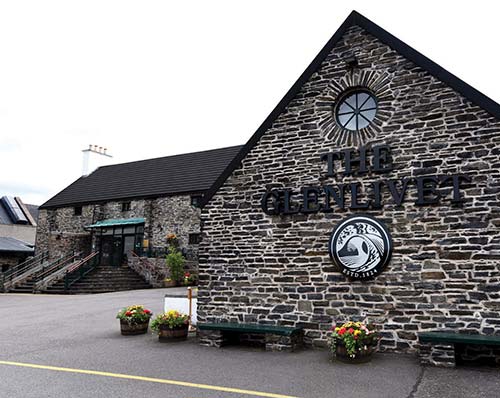
Cost and Hours: £10, daily mid-March-mid-Nov 9:30-18:00, tours depart every 30 minutes 10:00-16:30, closed in winter, head to the village of Glenlivet and follow signs from there, tel. 01340/821-720, www.theglenlivet.com.
Royal Deeside—the forested valley of the River Dee—is two sights in one: the Scottish home of the British royal family, wrapped in some of the most gorgeous scenery of Cairngorms National Park. Driving through the park you’ll see pockets of Scots pine (Scotland’s national tree). While no longer widespread, these once blanketed the Scottish countryside. In fact, 2,000 years ago the Romans must have been impressed. They called this land “Caledonia Silva,” meaning “wooded land.” Driving on, closer to Balmoral, you’ll enter a high, treeless moorland with lots of broom plants (what we’d call Scotch broom) and wild thistles (Scotland’s national flower). As you drive, cresting hills to meet vast views, you can imagine royals out on the hunt. (In fact, you’ll see tiny huts used by hunters to hide out while they await the stag of their dreams.) The only game you’ll likely see is hairy cows and lots of roadkill—mostly rabbit. (Hare today...)
The Queen stays at her 50,000-acre private estate, located within Cairngorms National Park, from August through early October. But in the months leading up to Her Royal Highness’ arrival, the grounds and the castle’s ballroom are open to visitors. While royalists will enjoy this glimpse into the place where Liz, Chuck, Billy, and Katie unwind, cynics are disappointed that only one room (the ballroom) is open to the public. Some find the visit overrated and overpriced. Because this is a vacation palace (rather than a state residence), it lacks the sumptuous staterooms you’ll see at Holyroodhouse in Edinburgh; this visit is about the grounds and the setting rather than the interior.
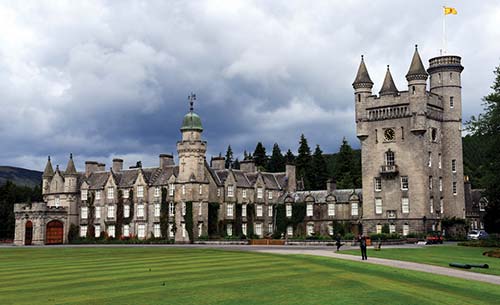
Cost and Hours: £11.50, includes audioguide, April-July daily 10:00-17:00, closed Aug-March, arrive at least an hour before closing, tel. 013397/42534, www.balmoralcastle.com.
Safaris: If you’re caught up in the beauty of Balmoral, consider booking a ranger-led Land Rover safari through the grounds (£60, 3 hours, 2/day during the open season).
Background: Queen Victoria and Prince Albert purchased Balmoral in 1848. The thickly forested hills all around reminded Albert of his Thuringian homeland, but Victoria adored it as well—calling it her “Highland paradise.” They remodeled the castle extensively in the Scottish Baronial style—a romantic, faux-antique look resembling turreted Scottish Renaissance castles from the 16th century—helping to further popularize that look. Ever since, each British monarch has enjoyed retreating to this sprawling property, designed for hunting (red deer) and fishing (salmon). The royal family was here when news broke of Princess Diana’s death. (Their initial decision not to return to London or to mourn publicly was highly criticized, as depicted in the film The Queen.) Today Balmoral has a huge staff, 80 miles of roads, a herd of Highland cattle, and a flock of Highland ponies (stout little miniature horses useful for hauling deer carcasses over the hills).
Visiting the Castle: From the parking lot (with a TI/gift shop, WCs, and the royal church across the street—described later), walk across the River Dee to reach the ticket booth. From here, you can either hike 10 minutes to the palace, or hop on the free trolley.
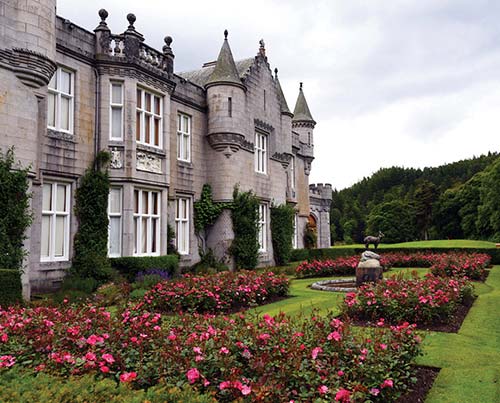
Once at the stables, pick up your included audioguide and peruse a few exhibits, including an 8-minute orientation film. In the main exhibit, you’ll see a video of the kilts-and-bagpipes welcome parade, plus a diorama of local wildlife, and lots and lots of historical photos of royals enjoying Balmoral—including about 60 years of royal family Christmas cards. Peek into the Queen’s garage to see her custom Bentley.
Then follow your audioguide on a short loop through the grounds and gardens before arriving at the palace. (To cut to the chase, or if the weather is bad, you can shortcut from the exhibit directly to the palace and the one room open to the public.) As you walk through the produce and flower gardens, ponder the unenviable challenge of trying to time all of the flowers to bloom and the produce to ripen at the same time, coinciding with the royal family’s arrival the first week of August (especially difficult given Scotland’s notoriously uncooperative climate).
Finally you’ll reach the single room in the palace open to the public: the palace ballroom. Display cases show off memorabilia (children’s games played by royal tots, and a fully operational mini-Citroën that future kings and queens have enjoyed driving around). Near the exit, a touchscreen offers you a virtual glimpse at the tartaned private quarters that are off-limits to us commoners.
Nearby: For a free peek at another royal landmark, stop at Crathie Kirk, the small, stony, charming parish church where the royal family worships when they are at Balmoral, and where Queen Victoria’s beloved servant John Brown is buried (£1 donation requested, daily 10:00-12:30 & 13:00-16:00, closed Nov-March). The church is just across the highway from the Balmoral parking lot.
The next town past Balmoral Castle (in the opposite direction from Ballater) is Braemar (bray-MAR). This tiny village hosts the most famous Highland Games in Scotland, as the Queen is almost always in attendance (first Sun in Sept, www.braemargathering.org). If you swing through town, you can take a look at its big games grandstand and its picturesque castle (not worth touring).
Ballater (BAH-lah-tur) is the place where you’ll feel as much royalist sentiment as anywhere in Scotland. For the people of Ballater (many of whom work, either directly or indirectly, with Balmoral Castle), the Windsors are, simply, their neighbors. Royal connections aside, Ballater is a pleasant, unpretentious, extremely tidy little town. Just big enough to have all the essential tourist services—but neatly nestled in the wooded hills of the Cairngorms, and a bit more “away from it all” than Pitlochry—Ballater is an ideal home base for those wanting to spend a night in this part of Scotland.

It was local springs—which bubbled up supposedly healing waters—that first put Ballater on the map. But there’s no question the town is what it is today thanks to Queen Victoria and Prince Albert, who bought the nearby Balmoral Castle in 1848, then built a train station in Ballater to access it. Today, the town’s best attraction may be its residents, who revel in telling tales of royal encounters. Prince Charles, who lives not at Balmoral but at Birkhall (not open to the public), has a particular affection for this part of the Cairngorms. He supports Ballater charities and has been known to show up unannounced at town events...and locals love him for it. (“Prince Charles is a really nice guy,” one of them told me. “Not at all like the chap you see on TV.”)
Sights in Ballater: The town’s only real sight—the old train station built by Queen Victoria to more easily commute to her new summer home at Balmoral Castle—suffered a fire in 2015. The artifacts housed in its minimuseum were saved, and the station should be reopened by the time of your visit. (It will have the TI, library, and an exhibit of how Queen Victoria relied on trains to get to Balmoral.)

The town is also fun for a wander. Facing the station are two stately sandstone buildings honoring the couple that put this little village on the map: the Prince Albert Hall and the Victoria Hall. Exploring the streets nearby, with their characteristic little shops, you’ll notice several boasting the coveted seals announcing “By Appointment of her Majesty the Queen” or “By Appointment of H.R.H. the Prince of Wales”—meaning that they’re authorized to sell their wares directly to the gang at Balmoral.
A block from the station—past the Balmoral Bar, with its turrets that echo its namesake castle—the unusually fine parish church is surrounded by an inviting green, with benches, flower gardens, and royal flourishes...like everything in Ballater.
Sleeping in Ballater: The town has several fine B&Bs; given the royal proximity and generally touristy nature of Ballater, prices are high...but so is quality.
$$ Osborne House is a big and cozy home, with spacious rooms, a walled garden, and delightful hosts Heather and Neil (4 Dundarroch Road, tel. 013397/55320, www.osbornehousebedandbreakfast.com, osbornehousebedandbreakfast@gmail.com). Just down the road past the Osborne House garden, look for the white fence surrounding the Victoria barracks—where soldiers tasked with guarding the Queen reside.
$$ Gordon Guest House, right in the center of town facing the historic train station, has five richly furnished rooms (Station Square, tel. 013397/55996, www.thegordonguesthouse.com, info@thegordonguesthouse.com, Martin and Amanda).
Eating in Ballater: If you’re just passing through, consider grabbing lunch at the old-school café $ The Bothy. Farther along the main street (toward Aberdeen), near the end of the strip of shops, $$ Rocksalt & Snails is a hipper choice. There’s also a handy, long-hours Co-op grocery store facing the parish church, and nice tables on the green. For a more serious dinner, Ballater has two good Indian restaurants (both facing the green) and a few hotel restaurants and pubs. $$$$ Rothesay Rooms Restaurant, sponsored by Prince Charles in 2016 as a charity project after the town suffered from devastating floods, has a good reputation (Wed-Sat 18:00-21:00, 3 Netherley Place near the church green, tel. 013397/53816, www.rothesay-rooms.co.uk). And $$$ Clachan Grill, serving modern Scottish cuisine, is about the most stylish and foodie place in town (Wed-Mon 17:00-21:00, closed Tue, tel. 013397/55999, look down a side lane near the bridge at 5 Bridge Square).
Scotland’s inlet-slashed, island-speckled west coast gets all of the attention...and should. But if you’re nearby, consider taking a peek at the east coast. While St. Andrews—with its links and beaches—is probably Scotland’s finest east-coast town, one uniquely hulking castle ruin rises above other coastal choices: Dunnottar Castle. For those who enjoy hiking on coastal bluffs and exploring ruins, it’s worth a detour on your way south from Ballater and Balmoral.
The mostly ruined, empty, and otherwise underwhelming castle of Dunnottar (duh-NAW-tur) owns a privileged position: clinging to the top of a bulbous bluff, flanked by pebbly beaches and surrounded nearly 360 degrees by the North Sea. It’s scenic and strategic. From the parking lot, you’ll walk five minutes to a fork: To the right, you’ll come to a ridge with a panoramic view of the castle’s fine setting; to the left, you’ll hike steeply down (almost all the way to the beach), then steeply back up, to the castle itself. Inside, there’s not much to see. The only important thing that happened here was the Battle for the Honours of Scotland, when the Scottish crown jewels were briefly hidden away in the castle from Oliver Cromwell’s army, which laid siege to Dunnottar (unsuccessfully) for three days. But don’t worry too much about the history, or the scant posted descriptions—just explore the stately ruins while enjoying the panoramic views, sea spray, and cry of the gulls.
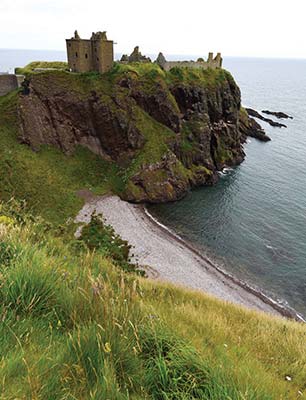
Cost and Hours: The photo-op view is free (and enough for many); entering the castle costs £7, daily 9:00-17:30, shorter hours Oct-March, tel. 01569/762-173, www.dunnottarcastle.co.uk.
Getting There: It’s just off the busy A-90 expressway, which runs parallel to the coast between Aberdeen and Dundee; exit for Stonehaven, and you’ll find Dunnottar well-signed just to the south.
Nearby: Dunnottar sits just beyond Stonehaven, a pleasant, workaday seafront town that’s a handy place to stretch your legs or grab some lunch (big pay parking lot right in the town center, ringed by eateries and grocery stores).